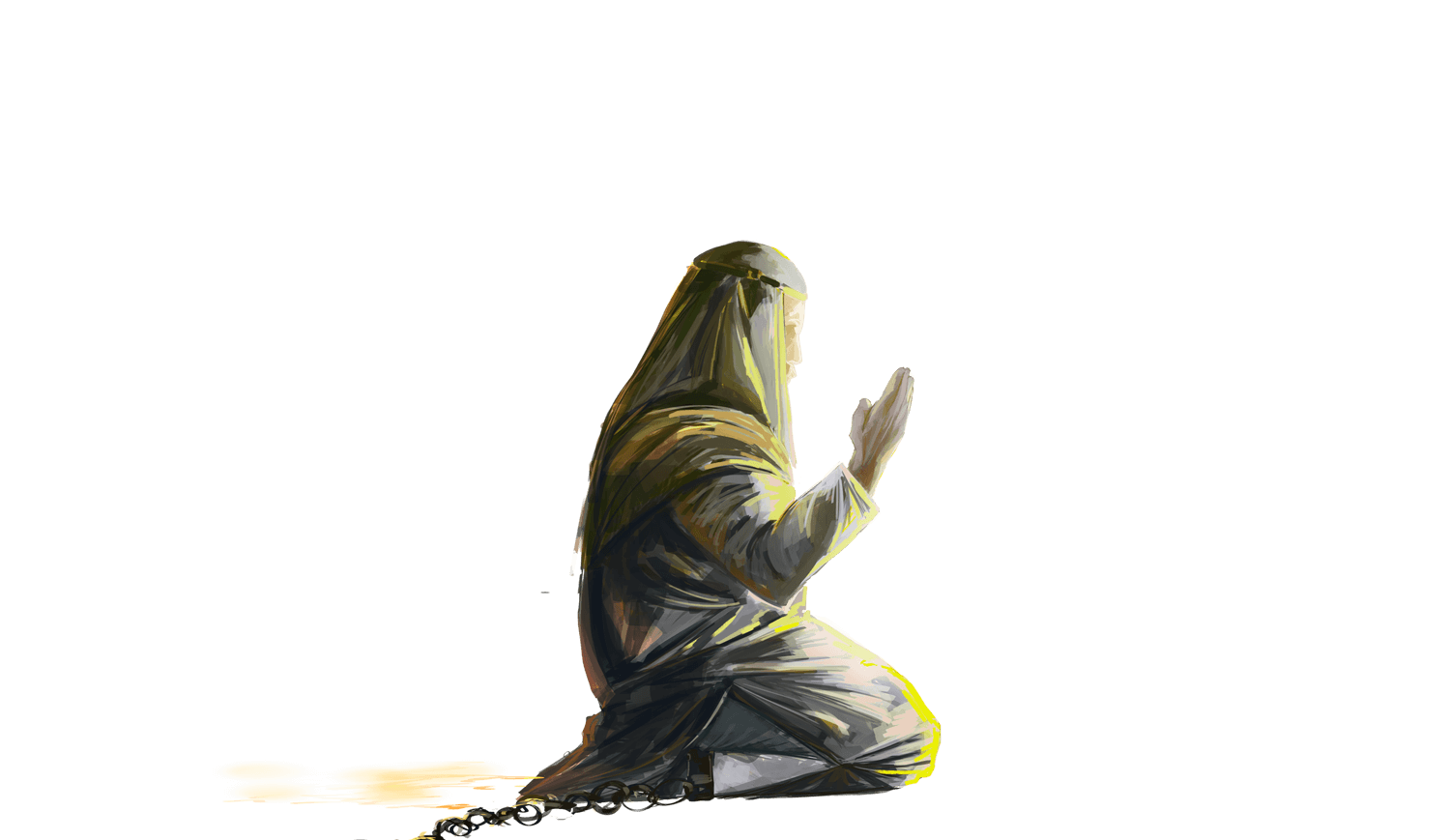The life of Imam Kazim was full of oppression, calamities, imprisonments, and life threats, which he endured from multiple Abbasid caliphs. With the unprecedented oppressive regime of the Abbasid government dominating the society, the Imam had a critical role to lead the Shia community, guide them in their religious beliefs, and save them from division. During the Imam’s life, he manifested the true meaning of his title, ‘Kazim’, the one who controls his anger. The Imam remained patient despite all of the calamities he was inflicted with by the government and the ignorant people. He was blessed by God with a special status known by the people of Iraq as ‘Bab al-Hawaij Ilallah’, which means ‘the door of fulfillment of requests from God’.
Imam Kazim
The Imam of Patience


Imam's Age
Birth
Imam Musa ibn Ja’far, also known as Kazim, was born on the 7th of Safar in the year 128 Hijri. He was born at al-Abwa, located between Mecca and Medina. Al-Abwa is the gravesite of Aminah, the Prophet’s mother. He was born as his parents were returning from Hajj. Imam Sadiq was very grateful for the birth of his son, Musa, and celebrated by throwing a feast for three consecutive days upon returning to Medina.
The Umayyad’s Downfall
Imam Kazim was about four years old when the Umayyad Caliphate was overthrown by the Abbasid Caliphate. The Umayyads, under the leadership of Abu-Sufyan, had been the main enemy of Prophet Muhammad (PBUH) during his prophethood. Surprisingly, these hateful enemies of the Prophet had a chance to control the rulership of the Prophet’s followers during the government of Muawiyah, who turned the Islamic caliphate into the Umayyad’s monarchy. The Umayyad caliphs were not afraid to publicly insult the Prophet, the Quran, or Islam, and would publicly indulge in sinful behavior.
Contrary to the Umayyads, the Abbasids, who were the descendants of Abbas, the Prophet’s uncle, were proud of being from the Prophet’s clan of Banu Hashim. They used their relationship with the Prophet to legitimize their government. They would respect the Prophet in their speech, and had an Islamic outlook for their government. However, the Abbasids’ crimes and murders against the people and the Prophet’s lineage outnumbered the Umayyad’s crimes. The number of people they killed to stabilize their government was far more than the people killed by the Umayyads. The Shia Imams at the time of the Abbasids faced the challenge of disproving the caliphate’s legitimacy and revealing the Abbasids’ true intentions for the Muslims.
Martyrdom of Imam Sadiq (AS)
Mansur, who had plotted to murder Imam Sadiq on several occasions, finally ordered Muhammad ibn Sulayman, his governor in Medina, to poison the Imam. Imam Sadiq’s martyrdom filled the entire city of Medina with grief, and the people came in crowds to his funeral. Imam Kazim took care of his father’s funeral and buried him in the Baqi’ cemetery by his father, Imam Baqir (AS), his grandfather, Imam Sajjad (AS), and his great uncle, Imam Hasan (AS).
Confusion in Recognizing the Imam
An unprecedented suppressive regime dominated society at the time of Imam Sadiq’s martyrdom. Mansur’s agents and spies were looking to identify and kill the Shia followers of Imam Sadiq. The Shias could not even hold a small gathering to discuss the next Imam. Imam Kazim could not directly call the people to his Imamat, as it could have led to his martyrdom. Although Imam Sadiq had indirectly specified Imam Kazim as the next Imam in his will, there was still confusion among the Shias about the next Imam. This was to an extent that, even some of Imam Sadiq’s loyal companions did not know the Imam of their time.
Mahdi and the Imam
After Mansur, his son Mahdi assumed power. At the beginning of Mahdi’s government, he was lenient in his treatment of the people and the Prophet’s lineage. Mahdi was looking to gather legitimacy for his new government after years of the tyranny and oppressive government of his father, Mansur. He distributed a large amount of the stored wealth in Bayt al-Mal (public treasury) among the people. He freed the prisoners and returned the properties that Mansur had forcefully confiscated from the people. He also returned the properties that Mansur had seized from Imam Sadiq to Imam Kazim. Imam Kazim knew that Mahdi’s policy was solely to stabilize his government. Once, the Imam came to Mahdi while he was returning the unlawfully confiscated wealth to their owners. The Imam asked Mahdi, “Why don’t you return the Land of Fadak (the Prophet’s gift to Lady Fatimah (SA) which was confiscated by the first caliph) to us?” He asked the Imam to define the boundaries of Fadak. The Imam defined the limits of Fadak as the four corners of the Islamic world of that time. With this response, the Imam implied that the entire Islamic kingdom belonged to him, and the Abbasid government was illegitimate. Mahdi, who was shocked and nervous by the Imam’s response, left his place.
With the passing of time, Mahdi became suspicious of Imam Kazim, as more and more people were referred to him as the Imam. Mahdi summoned the Imam from Medina to his palace in Baghdad, and imprisoned him. After a short period, he decided to kill the Imam. However, Mahdi saw Imam Ali (AS) in his dream, who recited the following verse of the Quran [47:22]: “May it not be that if you were to wield authority you would cause corruption in the land and ill-treat your blood relations?.” Mahdi was frightened by his dream. He understood that Imam Ali’s addressee was Imam Kazim, as he was from the children of Imam Ali, and also had a familial relation with the Abbasids. Mahdi summoned Imam Kazim from the prison and greeted him with respect. He asked the Imam to pledge that he would not rise against him, nor any of his children. The Imam responded that he did not have any intention for an uprising, and that was not his tradition. Mahdi then released the Imam respectfully, and the Imam returned to Medina.
Tragedy of Fakh
Hadi’s harsh policies against the Prophet’s lineage motivated them to pursue an uprising against the Abbasids and their unjust government. The Prophet’s lineage came around Hossein ibn Ali, who was one of their elders with a great personality. They encouraged him to initiate an uprising, which he finally accepted. He initiated his uprising in Medina, where he conquered the city. He then moved his troops of about 300 soldiers to Mecca to use the upcoming Hajj season as an opportunity to recruit from the Muslims and expand his forces. He eventually engaged in a battle with the Abbasid army, composed of around 4,000 soldiers, at a valley named Fakh outside Mecca, where he was defeated and martyred.
Imam Kazim had confirmed the uprising of Hossein, the martyr of Fakh. The Imam had informed him about his fate of martyrdom in his uprising. The Imam, who had witnessed his strong will for uprising, advised him to be strong and persistent in his chosen destiny, and wished him a great reward from God. When the Imam received the news of the martyrdom of Hossein, he cried and expressed his sorrow by saying that Hossein was a righteous believer, and unique in his family. The Imam testified that Hossein was martyred while he was inviting the people to good and forbidding them from evil.
Hadi’s Plot to Kill the Imam
When the hostages and the heads of the martyrs arrived at Hadi’s palace in Baghdad, he ordered the beheading of the hostages and hanged their bodies in the city. He angrily accused Imam Kazim of providing hidden authority and guidance for the uprising. Hadi claimed that Hossein, the martyr of Fakh, followed Imam Kazim’s order for the uprising, as the Imam was the most well-known person in the Prophet’s lineage. He then vowed firmly to kill and finish the Imam.
Ali ibn Yaqteen was a loyal companion of the Imam who held a high-ranking position in the Abbasid government. He sent a letter to the Imam informing him about Hadi’s absolute decision to kill him. The Imam showed Ali’s letter to his family and close companions. They urged him to hide or escape Hadi’s prosecution. However, the Imam responded that he had sought refuge in God by reciting the Jaushan Sagheer supplication, and that the Prophet had foretold him in a dream about Hadi’s death. The Imam told them that the news of Hadi’s death would arrive in Medina through the first messenger who would come from Iraq, which happened exactly as the Imam had predicted. Hadi passed away suddenly before being able to martyr the Imam, leading a short government of just 14 months.
Haroon and the Imam
In the beginning of Haroon’s government, he was lenient with the Imam. He knew that the Imam was the leader in people’s hearts, and that he, himself, was just a ruler overcoming them by sword and force. The Abbasids, who were proud of being related to the Prophet, exploited and abused this relation to deceive the people and legitimize their own government. However, this deception was not going to work against Imam Kazim and the other descendants of the Prophet, as they were more closely related to the Prophet than the Abbasids. There are multiple occasions when the Imam confronted Haroon, during which there were serious debates between them regarding their relationship to the Prophet.
Arresting the Imam
After years of being in power, Haroon began laying the groundwork to keep the Abbasid Caliphate within his own lineage. He selected his son, Amin, as his successor. He then selected his other son, Ma’mun, as Amin’s successor. He was concerned about the social popularity of the Imam and its consequences upon his sons’ future government. Any minor excuse was enough to trigger him to take action against the Imam. One such excuse was given to him by his minister, Yahya ibn Khalid Barmaki. Yahya’s conspiracy triggered Haroon to act against the Imam. Haroon wanted to get the Muslims’ allegiance for his son, Amin’s, nomination as his successor. He called the Muslims to Mecca for Hajj. On his way to Hajj, he stopped in Medina to arrest the Imam.
Haroon’s soldiers captured the Imam in the Prophet’s Mosque while he was praying next to the Prophet’s tomb. The soldiers interrupted the Imam’s prayers, forcefully took him outside the mosque, and brought him before Haroon. Haroon insulted and disrespected the Imam. He ordered the preparation of two caravans towards Iraq, one to Basrah and the other to Kufa. His intention was to leave the Imam’s destination unknown and to confront any attempt by the Imam’s followers to have him released. When the Imam was finally brought to Basrah as a captive, he was received by Basrah’s governor, Isa ibn Ja’far, who was Haroon’s cousin.
Prison of Isa ibn Ja’far
Isa ibn Ja’far imprisoned the Imam in a cell inside his own house. The Imam was kept in this prison for about a year. The door of his cell would open twice each day: once for delivering food and once to allow him to refresh his ablution. Isa ibn Ja’far was a corrupt character who would hold music and dance parties in his house. The Imam was harassed in this prison by the loud sounds of these parties. The Imam’s activities and prayers remained under intense surveillance by Isa ibn Ja’far’s agents. One of these agents had said that the Imam would repeatedly recite the following sentence in his prayers to God: “O’ my Lord, I used to ask you constantly to bless me with a quiet corner to pray and now I am thankful to You for fulfilling my request.”
Haroon frequently asked Isa ibn Ja’far to kill the Imam, but he would not accept Haroon’s order. He did not want to take the responsibility and blame for killing the Imam. His friends also advised him to do the same. After a year, Isa ibn Ja’far sent a letter to Haroon complaining to him about the lengthy imprisonment of the Imam in his house. He told Haroon that he would not kill the Imam, and if Haroon would not transfer the Imam, he would release him. He reminded Haroon that he was closely watching the Imam and had witnessed him in constant prayer. He stated that the Imam had never cursed nor said anything bad against anyone, including Haroon, in his prayers. When Haroon received the letter of Isa ibn Ja’far, he sent a delegate to transfer the Imam to Baghdad. The Imam was transferred to one of Haroon’s loyal politicians, Fazl ibn Rabi’, who was the son of Rabi’, one of the most trusted individuals to the Abbasid caliphs.
Prison of Fazl ibn Rabi’
Fazl ibn Rabi’ imprisoned the Imam in a cell in his house, secretly monitoring all of his activities. He witnessed the Imam fasting daily and that, except for a small part of the night, the Imam remained in constant prayers and long prostrations. After a while, Fazl ibn Rabi’ was influenced by the Imam’s character and prayers. He refused Haroon’s orders to finish the Imam. Haroon, who was disappointed at Fazl ibn Rabi’, ordered the transfer of the Imam within Baghdad to Fazl ibn Yahya’s house. Fazl ibn Yahya was one of Haroon’s loyal politicians and the son of his famous minister, Yahya ibn Khalid Barmaki.
Prison of Fazl ibn Yahya
The Imam’s character and prayers had great influence on the hearts of his jailers. Although Yahya ibn Khalid Barmaki encouraged Haroon to imprison the Imam, his son, Fazl ibn Yahya, who was keeping the Imam in his custody, was influenced by the Imam’s character. Fazl ibn Yahya witnessed the Imam in long prayers, prostration, and constant fasting. He changed his treatment of the Imam, giving him respect and comfort. When Haroon received the news that the Imam was in comfort, he became angry and ordered Fazl ibn Yahya be lashed. He ordered the transfer of the Imam in Baghdad to one of his most heartless and obedient agents, Sendi ibn Shahak, who was the head of the guard forces (police) in Baghdad.
Prison of Sendi ibn Shahak
The Imam’s imprisonment in the house of Sendi ibn Shahak was the hardest among his other imprisonments. Sendi ibn Shahak was a heartless military leader who would obey Haroon’s orders blindly.
Martyrdom
After around four years of the Imam’s imprisonment, Haroon had become completely hopeless to break the Imam’s resistance against his government and decided to kill the Imam. He left Baghdad and went to Raqqa, a faraway city in modern day Syria, to portray himself as innocent in the Imam’s martyrdom. He sent his minister, Yahya ibn Khalid Barmaki, to Baghdad with a secret mission to poison the Imam. Yahya was motivated to gain Haroon’s trust because Haroon had been disappointed by Yahya’s son, Fazl ibn Yahya, in how he had honored the Imam during the Imam’s imprisonment in his house. Yahya delivered Haroon’s order to Sendi ibn Shahak and gave him poisonous dates. Sendi served the poisonous dates to the Imam, which led to the Imam’s martyrdom. Three days after the Imam’s poisoning, his soul ascended. He was martyred on the 25th of Rajab, in the year 183 of Hijri, in Baghdad, at the age of 55.
Burial
In order to insult the Imam and his Shia followers, Sendi ordered only four of his soldiers to take the Imam’s corpse to the streets of Baghdad. He asked his soldiers to loudly announce in the streets of Baghdad, “Anyone who wants to see the body of the vicious, son of the vicious, come to us as we are carrying the body of the Imam of the Rafidhi.” Rafidhi was a derogatory term used against the Shias. They then placed the Imam’s corpse on the bridge over the Tigris River for part of a day. The people came to see the Imam’s corpse and witnessed that his body did not have any sign of torture or injury.
Haroon’s uncle, Sulayman ibn Abi-Ja’far, was one of the most influential members of the Abbasid royal family. He was in his palace by the Tigris River when he heard the turmoil and the people’s voices. When he was informed about Sendi insulting the Imam’s corpse, he condemned Sendi’s action, and found it politically unwise and dangerous for Haroon’s government. Though he did not believe in the Imamat of Imam Kazim, he was afraid that Sendi’s action could trigger the Shias, who were large in numbers in Baghdad and the other cities, to rise against the government. He sent his agents to take the Imam’s corpse from Sendi’s soldiers, and even advised them to use force if necessary. He then attended the Imam’s burial while barefoot. He told his agents to announce in the city that anyone who wants to look at the face of the blessed, son of the blessed, should come and look at the face of Musa ibn Ja’far. Crowds of Muslims then came for the Imam’s burial, and a respectful burial ceremony was performed for the Imam. The crowd carried the Imam’s corpse towards one of the city’s graveyards that belonged to the Quraysh, the tribe that the Imam, the Abbasids, and Banu Hashim belonged to, where they respectfully buried the Imam.





